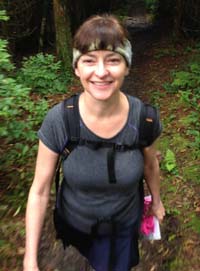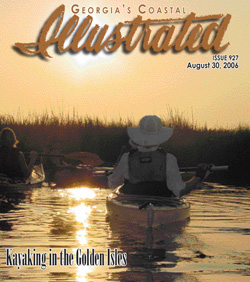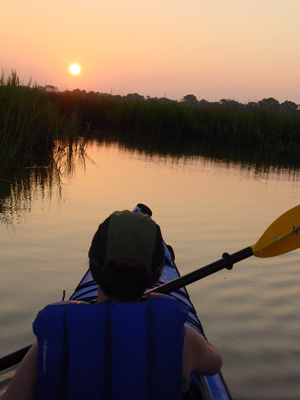  |
||||
| Home | Books | Recent Writing | ||
|
Kayaking the Golden Isles As we were the first to arrive, we waited for the rest of the group to gather – another eight people and a woman joining the tour with her own kayak – and we waited for the sun to rise a bit more. We waited for everyone to gather
Divorce boat? If a couple can’t work together, it seems, arguments can ensue not to mention a knock on the head from an uncontrolled paddle or getting doused by water if you hit the water incorrectly with the same paddle . . .
Fortunately, Frank and I have been working together for more
than 20 years now, starting with working together on our college yearbook,
proceeding to newspaper work and eventually a freelance career.
Through-hiking the Appalachian Trail together didn’t hurt our teamwork
either and sure enough, our voyage through the marsh went quite smoothly. Our guides then helped us move our kayaks into the creek and we were soon underway. It was the perfect time of day for a kayak tour – the sun rising slowly over the marsh, the air still relatively cool from the previous night’s thunderstorm. As we paddled along, Mark and Mandie introduced us to the marsh by pointing out various things as we passed them. From marsh rack to a beautiful Great Blue heron, we were able to observe and learn about the finer details of the salt marsh. As we pulled into a wider spot at Bloody Marsh, we drifted to a stop to listen to Mark tell us about one of the most important battles in American history. Perhaps it wasn’t as bloody as it was made out to be, but the Battle of Bloody Marsh determined the course that America would take in the ensuing years. From Bloody Marsh, we continued our paddling toward Gould’s Inlet, crossing the inlet (where we were treated to a magnificent jump by a tarpon) and grounding ourselves on the beach at Sea Island.
As much time as I have spent on the beach over the years, I am not sure why I wasn’t aware of this fact. Essentially, what it means is that even private property owners can’t keep you from walking along the beach although legal battles abound over attempts to block the public from homes and other properties that sit on the beach. Which is why, of course, Southeast Adventure Outfitters (in this case) could take us over to the privately owned Sea Island, with its bird sanctuary and mostly unpopulated beach, for a quick break. During our amble, Mark found a beautiful lettered olive shell, which he presented to me as a souvenir. I found a small, perfectly formed whelk, that was, unfortunately, inhabited and I left it on the beach to hopefully live another day. We checked out a few sea turtle nests and I fussed at the ghost crabs that were attempting predation of the eggs before we rejoined the group to return to our kayaks. After we had crossed the inlet once more, we landed on the beach at St. Simons Island. We dragged our kayaks up to the road, voluntarily, and Mark drove us in the Southeast Adventure van back to our cars, which had been left at the Maritime Museum. It was a pleasant and invigorating morning and ended in time for us to grab some well-deserved breakfast. Kayaking Opportunities
in For those interested in kayaking, there are plenty of opportunities to take a tour through the “wide sea marshes of Glynn” immortalized by Sidney Lanier. Seeing the marshes from the view of a sea kayak helps you gain an entirely new perspective on this important part of the coastal ecology.
“We get out into the salt marsh and paddle along several different tidal creeks, including some that parallel the causeway that leads to the island,” explained Tom Woolf, environmental educator and head kayak guide with the center. “During the trip, we teach about the marsh and the wildlife that can be found in it.” Woolf said the tour also includes a trip to a shark tooth dredge spoil where participants can spend a few minutes hunting for shark teeth, adding that St. Andrews and Cumberland Sounds were known for the number of sharks that mate in their waters. Like all kayak tour operators, Woolf said Tidelands gives basic instruction in kayaking before beginning a tour. “ I like to say that you sit in a canoe, but you wear a kayak,” he added. He also stressed the importance of using your waist to help in paddling. “If you turn your waist rather than move your arms excessively,” he explained, “your arms will not get tired as quickly. Tidelands offers kayak tours Monday through
Friday (and, occasionally, on Saturday). Lee Scriven at Barry’s Beach Service said that they book kayak tours through Ocean Motion. “We try to do two trips a day of two to two-and-a-half hours each,” he said. Scriven said it is $39 per person and the times vary daily according to the tides. “A minimum of two people are needed for each tour,” he added, “and we can take as many as 10 out on a tour.” But, he warned, if you have a group numbering more than two, it is best to reserve at least two days in advance. Southeast Adventure Outfitters owners Michael Gowen and Cindy Janus offer a variety of options when it comes to kayaking. From the shortest – a Brunswick kayak tour of two hours for $35 or the three-hour St. Simons Island tour for $50, in which the basic skills are taught and practiced – to everything from a half-day tour ($65), day trips for $80 and even overnight and weekend trips ranging upwards to $350-400, in which all necessary gear and food are supplied. Daily trips, particularly, vary according to tide schedules. For additional information or to book tours,
call:
|
||||
|
|
||||

 We
were asked to meet at the tidal creek at 6 a.m. but on this particular day,
6 a.m. meant pitch black dark. So, when my husband and I crossed the bridge
over creek, we saw no humans but could hear the sound of kayaks being
dragged down to the creek. We announced our presence and two voices
responded with a “hello” and a couple of dimly seen figures ascended the
bank to check us in. We signed our waivers by the light in the cab of the
truck, which had hauled the kayaks to our departure spot.
We
were asked to meet at the tidal creek at 6 a.m. but on this particular day,
6 a.m. meant pitch black dark. So, when my husband and I crossed the bridge
over creek, we saw no humans but could hear the sound of kayaks being
dragged down to the creek. We announced our presence and two voices
responded with a “hello” and a couple of dimly seen figures ascended the
bank to check us in. We signed our waivers by the light in the cab of the
truck, which had hauled the kayaks to our departure spot.  It
wasn’t long for things to merge from black to gray and finally colors could
be seen.
It
wasn’t long for things to merge from black to gray and finally colors could
be seen. As
we took a half hour break to skim the beach for shells, Mark informed us
that federally we have a right to public access to the beach. I Googled that
later and found that the first public beach access law was passed by the
United States in 1935 with the proviso that each state would determine where
the public access line ended. In Georgia, the public has access of the beach
up to the mean high water mark (the mean being determined from an 18 year
average).
As
we took a half hour break to skim the beach for shells, Mark informed us
that federally we have a right to public access to the beach. I Googled that
later and found that the first public beach access law was passed by the
United States in 1935 with the proviso that each state would determine where
the public access line ended. In Georgia, the public has access of the beach
up to the mean high water mark (the mean being determined from an 18 year
average). The
kayak tours offered by Tideland’s University of Georgia 4-H Center on Jekyll
Island focus on educating people on coastal ecology.
The
kayak tours offered by Tideland’s University of Georgia 4-H Center on Jekyll
Island focus on educating people on coastal ecology.
